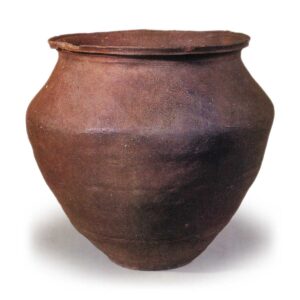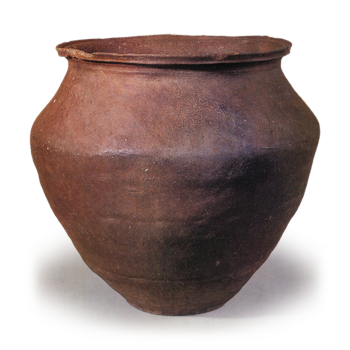
Excavated from Ono City, Fukui Prefecture
Marked “1323”.
Height 60.1cm, Bore 51.7cm, Body 66.0cm, Bottom 23.4cm
Hakone Art Museum
There is nothing more similar to a Tokoname large jar than an Echizen large jar from the Kamakura period (1185-1333). The shape of the rim band, the tension of the shoulders, the small base, and other aspects of the shape give the impression of Tokoname itself, and in many cases it is impossible to distinguish between the two without being in contact with the actual piece. This is not surprising considering the fact that Echizen pottery was established with the introduction of Tokoname techniques. The slight difference in the clay and the kiln marks on the shoulders indicate the difference between the two. In the late Kamakura period, there are differences in the mouth rim band. The mouth rim band of Tokoname jars from this period is wider, but that of Echizen jars does not hang down in the shape of an “N.” This rim band was originally the rim of the jar. This rim band was originally intended to prevent damage to the jar’s rim, so Echizen ceramics made of highly refractory clay do not need such a wide rim band. This jar is one of the few Echizen large jars from the Kamakura period (1185-1333) that bears the inscription “Gen’toru 3 □atsuka 9” on the shoulder. It is valuable as the only reference material for Echizen large jars from the late Kamakura period. On another side of the shoulder, there are two kiln marks with seven vertical lines in a row.



